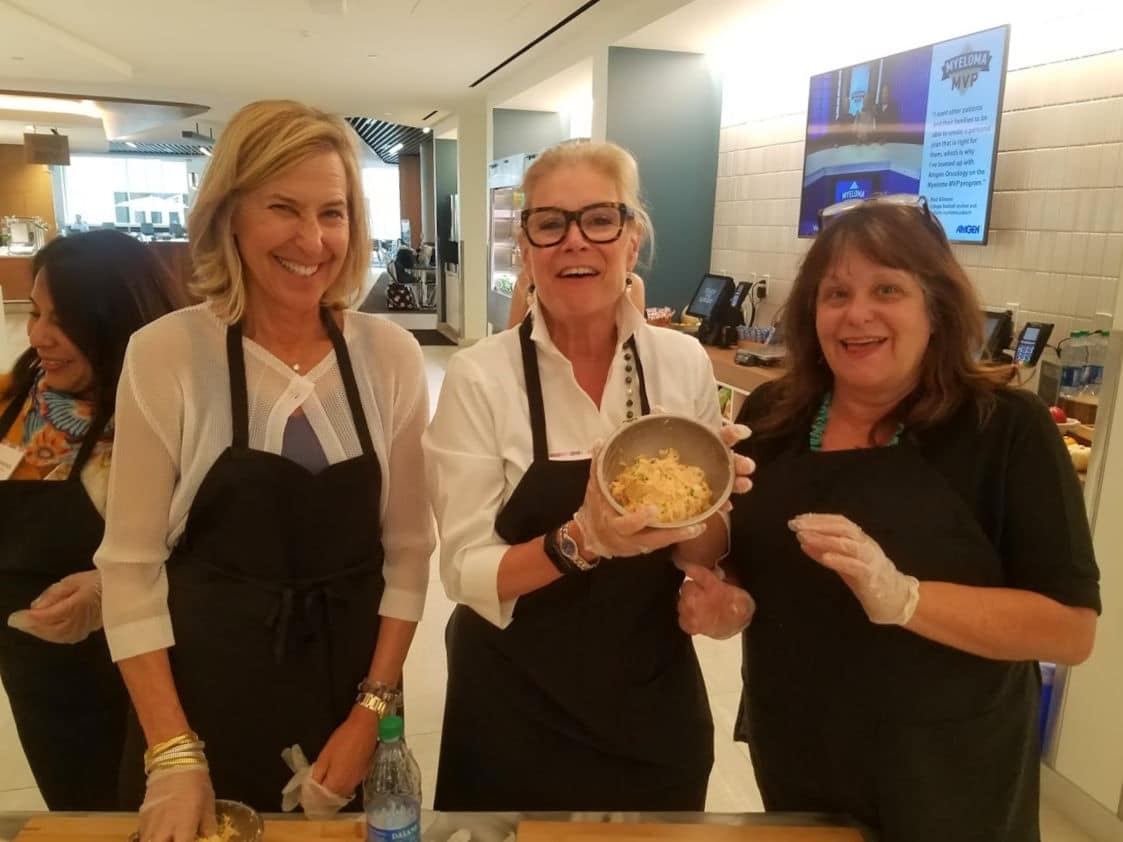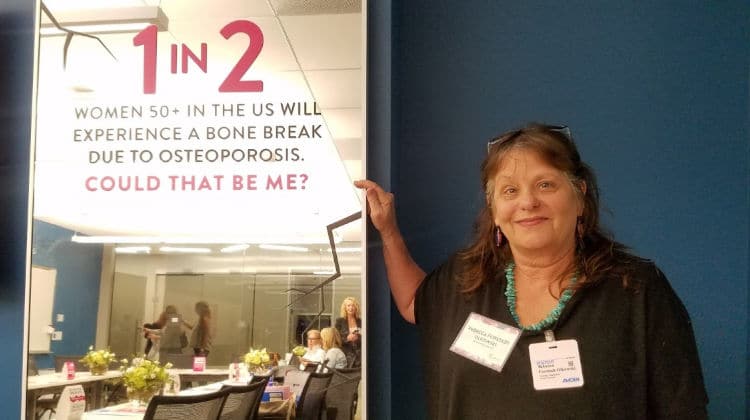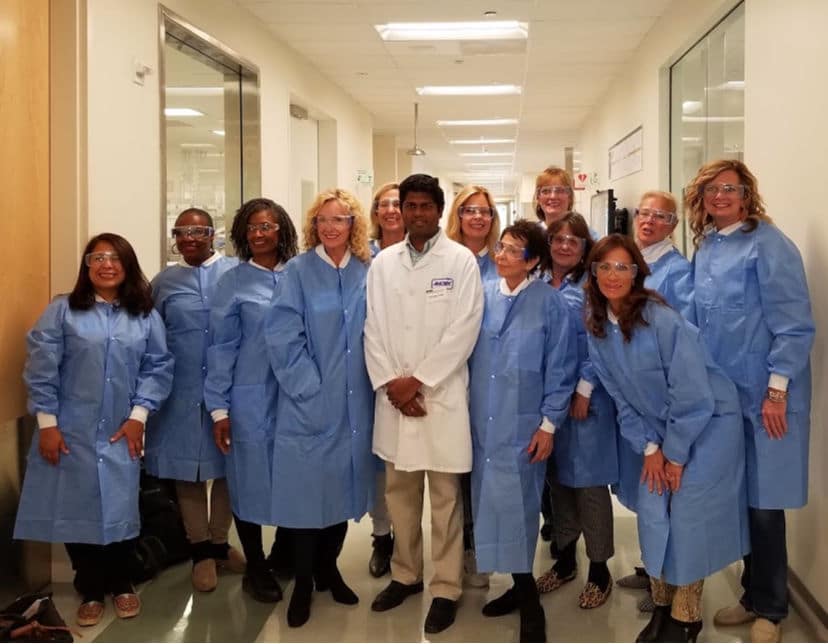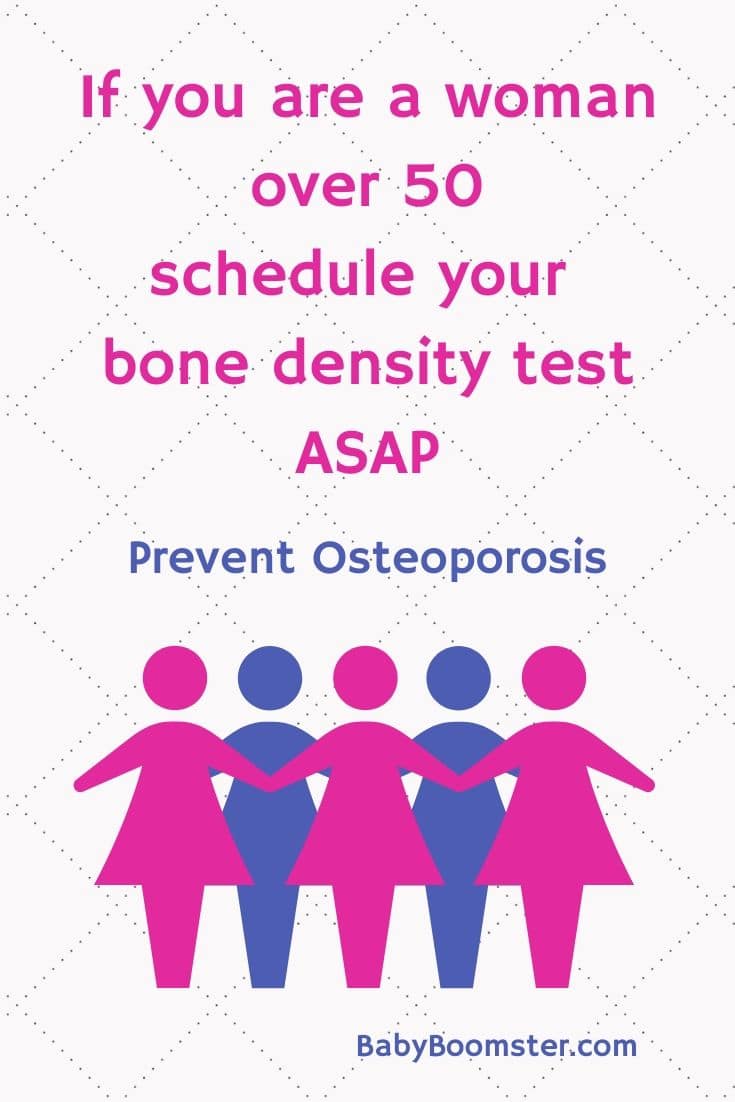I had my bone density scan, which is recommended for women 50+. It’s a quick and easy low-radiation test that takes no more than 10 minutes to complete but it’s so important for our age. My scan indicated that I have Osteopenia. That sounds ominous, but it’s just a scary-sounding name for some bone loss, which is not uncommon for a woman over 65 like me.
A visit to Amgen Labs
I attended an Osteoporosis Summit at Amgen in Thousand Oaks, California. Amgen invited a group of over-50 bloggers/influencers to spread awareness about bone health. Some of the ladies flew in from all over the country but I was local. We spent a thoroughly enjoyable evening and an entire day together meeting with experts in the field and touring the facilities.
Amgen is a biopharmaceutical company that develops treatments and medicines for serious diseases like cancer. They work with living cells rather than just chemicals to make biological medicines. However, the purpose of our visit was purely educational and eye-opening, to say the least. World Osteoporosis Day is in October.
Why older women need to be concerned about bone density
Here are some facts:
- 1 in 2 women over 50 in the U.S. will break a bone due to osteoporosis in their remaining lifetime.
- Breaking a bone is often the first sign of osteoporosis.
- Some women lose up to 20% of their bone density in the 5-7 years following menopause.
- Breaking one bone due to osteoporosis puts you at a higher risk of breaking another.
- Every year in the U.S., osteoporosis is responsible for 2 million broken bones and $19 billion in related costs.
- A healthy diet and exercise are important, but for women with osteoporosis, they are often not enough on their own.
- About 80% of people at high risk, who have already had at least one osteoporosis-related fracture, go undiagnosed and untreated for osteoporosis.
- Women over 50 should ask their doctor to order a DXA scan (bone density test)
If that isn’t enough to get you to call your doctor to schedule a bone density scan, I don’t know what is. Here’s something I didn’t know. If you are over 65 in the U.S., your bone density scan is covered under Medicare.
How to take care of your bones
The first thing in the morning, we started with a yoga session outside of the Westlake Valley Inn that most of our group was staying in. Yoga is an excellent exercise to prevent bone loss because it’s a weight-bearing exercise. Other weight-bearing exercises include:
- Walking, running, hiking
- Pilates
- Dancing
- Zumba
- Weight training
An exercise like spinning is excellent for your heart but isn’t weight-bearing. Make sure to include some type of weight-bearing exercise into your exercise routine. Even gardening and cleaning your house will count.
Practicing balance exercises is also crucial as you age. One fall can have devastating results. If you are looking for an exercise program, make sure it includes balance exercises.
Targeted nutrition can help reduce bone loss
My doctor recommended that I take a calcium and Vitamin D supplement since my bone loss isn’t severe enough to require medication. You can easily get enough calcium by eating calcium-rich foods, but the recommended amount is 1000 – 1200 mg. You also need at least 400 IU of vitamin D because it helps to aid in calcium absorption.
Tip: If you are choosing a calcium supplement calcium citrate, like Citracal, is less dependent on stomach acid for absorption like calcium carbonate and also contains Vitamin D.
According to the Harvard Medical School, a 4 oz serving of plain Greek yogurt equals 300 mg of calcium. 1 oz of cheddar cheese is 205. A 3 oz piece of salmon is 180.
Some plant-based foods also contain calcium. But while collard greens equal 360 mg, most vegetables are low in that nutrient. If you’re vegetarian or vegan, you may want to consider consuming foods that are calcium-fortified such as almond milk and oatmeal, or take supplements.
If you can get enough calcium with food alone, that’s always best. Taking too much calcium via supplements can cause kidney stones or even increase your risk of a heart attack.
Vitamin D comes from sunshine exposure but you can’t depend on spending time outside to get what you need. Even in Los Angeles, sun exposure isn’t strong enough to give us the required amount. You will probably need a supplement.
We also need protein to keep our bones healthy because it contributes to bone mineral density. You don’t necessarily need a high protein diet, but you still need to consume an adequate amount. The current protein recommendation (RDA) for a 150 lb woman is 0.8 protein per kilogram or 55 grams. However, it may be too low for those over 50 to prevent fractures. According to a recent study, healthy older adults should consume at least 1.0 to 1.2 g protein/kg body weight/day. (a 150 lb woman over 50 needs 69-81 grams and a 180 lb. man over 50 needs 81-98 grams)
Again, vegetarians and vegans will need to be careful and work harder to get enough protein in their diets. Animal protein contains all nine essential amino acids that our body needs but plant protein does not. I always recommend the Mediterranean or Pescatarian-style diet (only fish as protein) for that reason, (my opinion) because both include small amounts of protein and are balanced.
See my Food Pyramid for Foodies
Our cooking class

As part of our day, we had a fun session making wild salmon cakes with cucumber cooler dip. Find the recipe here.
Our tour of the labs
All of us suited up in lab coats, protective glasses, and closed-toed shoes to take a stroll through some of the Amgen Labs. We were greeted by super-smart scientists who explained how Amgen develops drugs and other treatments to cure diseases.
In case you aren’t familiar with the company, Amgen is known for its meticulous testing as well as outstanding quality control. Our tour was impressive, and the entire campus is amazing! They have a childcare facility for 400 kids, a soccer and basketball field, and gorgeously-designed grounds and workspaces. We were impressed.
The osteoporosis panel at Amgen
We participated in a panel discussion led by Barbara Hannah Grufferman, who is a recognized expert on positive aging. She’s also the author of the book, “Love Your Age: The Small Step Solution to a Better, Longer, Happier Life.”
Barbara told the story of her mother who was active and independent before experiencing a fall that broke her hip. It turned out she had osteoporosis and didn’t know it. Her fall changed her life forever and she’s now in assisted living. What’s scary is that the same thing can happen to any of us at our age. If you’re over 50, even a simple fall can be life-changing.
The other panelists included Dr. Andrea Singer, Chief Medical Officer for the National Osteoporosis Foundation, Dr. Michele McDermott, US Medical Director for Amgen, and Dr. Mary Oates, US Medical Director for Amgen.
Takeaways from the Panel
- One of the greatest financial risks for people over 50 is health.
- Osteoporosis is a systematic skeletal disease that causes a decrease in bone density. It causes bone fractures in the population every 3 minutes.
- 54 million people in the U.S. are estimated to have osteoporosis and low bone density.
- A break or a fracture means the same thing. Some people believe the two terms are different as if a fracture is less critical than a break.
- Osteoporosis is different than osteoarthritis. Osteoarthritis is a disease of the joints and osteoporosis is a disease of the bone.
Know your T-score
- A T-score of -1.0 or above is normal bone density. Examples are 0.9, 0 and -0.9.
- A T-score between -1.0 and -2.5 means you have some bone loss or osteopenia.
- A T-score of -2.5 or below is a diagnosis of osteoporosis.
The lower a person’s T-score, the lower the bone density.
What causes bone loss?
- Osteoporosis doesn’t just affect little old ladies or just skinny older ladies. Anyone can be diagnosed with it.
- After the age of 30, women begin to lose estrogen which can cause bone loss. Those who are post-menopausal are at the highest risk.
- You can prevent low bone density by not drinking too much and by not smoking.
- Check to see if members of your family have been diagnosed with osteoporosis in the past. If so, you may be at higher risk.
- If you fall and fracture a bone you will, at least temporarily, lose strength and mobility which can cause complications or an increased risk of falling again.
Whatever you do – DON’T FALL!
Have you taken a tumble recently? Make sure to check your balance and do exercises to improve it.
You can improve your risk of falls by making sure your home does not have obstacles that can cause you to fall. Watch that sneaky chihuahua!
Avoid wearing high heels – I know, I know – they’re chic and fashionable. The problem is, that they put you at high risk for fracture. If you must wear them, don’t step in a hole, and make sure the heels are sturdy and not in danger of breaking. (That’s my tip)
Opt instead for flatter and sturdier shoes. Have you ever fallen out of a sandal? I have! Sandals are as easy as high heels to fall out of if you aren’t strapped in.
Hold on to the railings when you go downstairs or on escalators. (I learned this in charm school when I was 12-years old)
If you are even slightly dizzy, sit down on the floor immediately. Don’t wait until you faint, as I did on two occasions.
Simple steps to improve your fall risk
Improve your diet by eating bone-healthy foods. You may want to try my recipe for homemade bone broth.
Add weight-bearing, strength training, and balance exercises to your workout regime.
As I mentioned before, the bone density test is part of your Medicare coverage if you are 65+. But, even so, only about 9% of women get one.
Medicare reimbursements have been cut and some clinics have closed. Please, please, PLEASE, message your Senators and Congresspeople so women over 50 have access to bone density scans.
It’s never too late to improve your bone health. You may not be able to reduce bone loss that has already occurred, but you can improve your chances of it getting worse.
Have you had a bone density test yet? If not, call your health provider and schedule one TODAY. Then, talk to your doctor about a bone health plan based on your results.
Natural ways to prevent your bones from weakening
As older women who are aging, it’s important to do everything we can to prevent osteoporosis, especially if you’re a woman. It’s a degenerating bone disease that leads to a risk of fracture. If your bones are brittle and break, you may be in danger of having a lifelong disability and/or chronic pain.
There are supplements to decrease your risk, but it’s what you eat that counts the most.
Foods you should avoid that will weaken your bones
Excess salt
A diet high in salt causes the minerals in your bones to deteriorate.
Salty foods include:
- Hot dogs, and packaged deli meats (turkey, ham, beef, etc.)
- Fast Foods – fries, pizza, tacos, burgers
- Frozen dinners including reduced-calorie meals
- Canned soups, vegetables, and vegetable juices
- Processed bread and breakfast cereals that are not whole grain.
Soft Drinks
Carbonated beverages increase bone loss because they contain excessive levels of phosphorous. In America, many people cannot go through the day without a Coke or 7-Up. There are no nutritional benefits to any soft drink and they are usually high in sugar or sugar substitutes are known to cause cancer. Substitute your soda pop for orange juice fortified with calcium and vitamin D, fruit smoothies made with yogurt and banana, low-fat milk, or chocolate milk.
If you love carbonation, drink sparkling mineral water that’s free of phosphoric acid and squeeze in a lemon, lime, or another fresh fruit juice.
Caffeine
Caffeinated beverages can leach calcium from your bones and make them weaker. Go easy on coffee and caffeinated tea.
Sugar and Sugar Substitutes
Excessive amounts of sugar create high levels of cortisol that may cause osteoporosis. Stick with stevia, honey, or maple syrup. Artificial sugar substitutes don’t cause osteoporosis directly but are known to cause cancer.
Eat these foods to prevent Osteoporosis
Humans need protein. Our bones are approximately 50% protein and require a steady stream of amino acids.
Foods high in protein that also contain calcium are:
- light tuna
- fresh or canned salmon
- canned sardines or anchovies
- Fat-free plain yogurt
- reduced-fat milk and cheeses
- eggs
Try the bone healthy salmon cakes recipe that we made at this event.
If you’re vegetarian or vegan it’s important to eat alternative protein sources to prevent bone loss. In some cases, supplementation may be needed.
Vegetarian sources of protein:
- hemp
- non-dairy milk
- nut butter
- quinoa
- tofu
- lentils
- beans
- tempeh
- sprouted whole grain bread
Be aware that soy products like edamame, tofu, tempeh, and soy beverages are rich in bone-building protein, but may contain plant compounds that will hamper calcium absorption.
Other foods that are known to help build and maintain healthy bones include;
- Fresh green peas – high in vitamin K, B6, and folate
- Spinach – high in vitamin K, folate, vitamin B6, magnesium, and calcium
- Green tea – Alkalizes tissues and contains trace elements essential for bone health. Avoid sweetened green tea
- Asparagus – Alkalizing and a good source of trace elements. One of the most nutritionally balanced vegetables and very good for bone health
- Steel Cut Oats contain minerals essential for bone health. Instant oatmeal contains junk additives and should be avoided.
- Parsley – High in vitamin K1, folate.
- Lemons – alkalizing (although it is an acidic fruit) High in trace minerals needed for bone health. Because lemons are high in vitamin C drinking lemon juice mixed with pure water will help you absorb calcium into your body.
Broccoli, Kale, Collard Greens, Pumpkin/Squash, Black Eyed Peas, Beans Blackstrap Molasses, poppy seed, sesame seeds, almonds, figs, and Organic Dairy are additional bone-building foods.
Other Lifestyle Changes Needed to Prevent Osteoporosis
Keep moving
Baby Boomers and seniors need to keep up activity levels and avoid becoming sedentary. Safe exercises include walking, swimming, yoga, dance, moderate strength training, and even light jogging. If you’re just beginning an exercise program, ease into it and avoid extreme sports that may cause injuries.
Excessive weight loss or low body weight may contribute to Osteoporosis
A person over 50 who is too thin has less padding and fat and is more vulnerable to injury. Frequent dieting or extreme weight loss will cause a person to lose not only fat and muscle but also bone density. Fat and muscle will eventually come back but bone density loss may be permanent. It’s safer to lose weight slowly and to maintain a weight that is neither too skinny nor overweight.
In other words, you may not want to set a goal to be as skinny as you were in high school. Besides, a few curves are sexier and may be better for you in the long run. Have your doctor run a test for bone density at your next exam.
Disclaimer: Amgen paid for my travel for this event, but my views are my own.
A big thank you to the team at Amgen for hosting our summit on osteoporosis and I loved meeting all the ladies who are midlife influencers who I had met online but now met in person. You all rock!
Have you had your bone density scan yet? If not, what’s stopping you? Please leave a comment below.








Rebecca, What a great group of fabulous women! As a breast cancer survivor I also know that weak bones are places breast cancer could recur so for me, that’s also a good reason to be aware of my bone density. xoxox, Brenda
That’s so important to know, Brenda. Thanks for mentioning it. You are so right!
Thanks for this information. I think I need to schedule a bone scan.
I hope you do, Jennifer. It only takes a few minutes to do and if important to know.
Most insurances will not cover a dexascan at age 50,
It is only covered by Medicare.
Some providers, hospital staff are beginning to evaluate this mostly Women’s Wellness issue.
Early tooth deterioration is also an early symptom. Hereditary, mostly Asian and Caucasian women are at great risk.
Smoking and alcohol consumption.
All together these should justify an early scan.
Just earned of a new program at Allegheny Health Network in which through an assessment and interview a physical therapist can justify an early bone scan.
If healthcare’s new direction is mental health wellness and prevention. I can think of no better referral than a baseline bone density scan.
Thanks
Thanks, for sharing this, Rose. That’s why we recommend that everyone contact your representatives in Congress and the Senate. DXA exams are important for women at risk for osteoporosis and age shouldn’t be an obstacle.
Great tips. Sounds like a wonderful conference. Chemotherapy can encourage bone loss so I have had numerous bone scans.
You’re absolutely right. Chemo takes a toll on everything and bones are one of them.
Sounds like a great event. I was sorry to miss it due to health issues. I enjoyed reading your recap. This is an important health concern for women over 50. I try to eat more calcium rich foods and exercise. It’s such a balancing act as we age.
Oh, it would have been great to see you Judy, but i understand. I had to go back and forth instead of stay at the hotel because I was taking care of a man and dog at home who need meds. I love that it gives us the go ahead to eat cheese without guilt. LOL
this is very informative and useful for those who are interested in the good health of own mother.
really explains everything in detail, your blog is very informative and effective. Thank you for this type of important information